NYC Psychologist
SFT
SELF-Focused Therapy
Full Description
Nurture + Respect Your SELF =
Self-Empowerment
SFT SELF-Focused Therapy is the demonstrated highly-effective, integrated non-reductionist psychotherapy conceived and developed by NYC Psychologist founder, Dr. Rita M. Haley. You probably have many questions but the most important is this: "Can SFT help me?"
The answer is simple.
Are you anxious or depressed? Do you feel lost, overwhelmed, unable to cope?
Is it difficult for you to get organized, set priorities, adapt to change?
Are you lonely, shy, afraid to socialize or meet new people? Do you feel good about yourself? Is your self-esteem what it should be?
Is saying "no" to others a problem for you? Are you kind to everyone except yourself? Do you find yourself trying to please others at the cost of your own wants and needs?
Do you seem unable to find healthful, fulfilling relationships?
Is something something stopping you from achieving, perhaps even striving for or identifying your goals and ambitions?
If your answer to any of these questions is "yes" --- SFT was designed to help you.
Table of Contents
Want the "cliff notes" summary version? See our FAQs
SFT Introduction
A basic tenet of SFT is this: Most psychological problems stem from constraints you internalized in your youth.
That's worth repeating.
Most psychological problems stem from constraints you internalized in your youth.
SFT is designed to aid you in shedding these constraints, for they cause your anxiety and depression; leave you feeling lost, overwhelmed, unable to cope; underly your low self-esteem; and stop you from achieving your goals and ambitions.
These constraints cause you to
be unkind, even mean to your SELF, to disregard and disrespect your SELF. They prevent you from being the person you can, deserve, and are meant to be. The person you really are: Your Real SELF.
How does SFT help you reclaim and empower your Real SELF? By helping you learn to nurture, respect, and yes love your SELF as s/he is. In SFT, you learn to:
![]() Treat your SELF with
kindness and compassion
Treat your SELF with
kindness and compassion
![]() Respect your [SELF's] feelings and needs
Respect your [SELF's] feelings and needs
![]() Set responding to those feelings and fulfilling those needs as your top priority
Set responding to those feelings and fulfilling those needs as your top priority
With the help of SFT, you free your SELF from the constraints that underly your psychological problems including the unreasonable rules you learned in childhood (but still follow today).
For many of you, these rules require you to be SELF-less[1],
SELF-sacrificing, un-SELF-centered[2], and
consistently unSELFish[3] ; they require you to protect the feelings of others over your own, to make your needs and desires less important than those of others.
For some of you the rules require that you not be angry, anxious, afraid, lonely, dependent, independent, sad, self-indulgent. The list goes on and on.
For each of you the rules are different. But, for all of you, the constraints of your childhood created rules, many of which are unreasonable. And, it is the rigid adherence to these rules that underlies your psychological difficulties.
In SFT we refer to your set of rules as your "Rule Book," -- your book of shoulds. During the course of treatment, you remove the pages and finally discard the book. You empower your Real SELF to govern the tyrannical enforcer of those rules, the dictator SFT labels your Objectified Self.
No, SFT does not turn you into an ego-maniac or a "softie," but rather
into an adaptive individual who chooses when and if to sacrifice your wishes in the service of others, who is capable of having healthful, rewarding relationships.
To Table of Contents To Top of Page
SFT Description
Background
How
did this new treatment come into being?
SFT
was developed by Dr. Haley who, during the course of her work as a
Psychologist and Women’s Rights activist and leader, noted that many,
perhaps most, women and girls engage in self-defeating behaviors and often seem
unable or unwilling to act in their own best interests. The same, she noted is true of many men though the self-detrimental actions typically are different.
SFT
and the frame upon which it was built were conceived in response to these
observations.
To Table of Contents To Top of Page
Framework
Most
of the psychological and psychiatric problems you experience are caused by
impediments you internalized in your youth.
How did you get stuck with such “crummy” constraints?
From
the moment you are born, you begin to develop a SELF. For our purposes here, we
call her your Real SELF though
initially she was your only SELF.
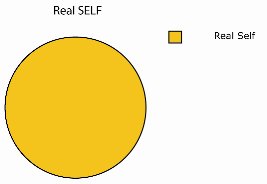
Unless
you grew up in “PerfectLand,” as a child, in response to the demands of your
environment[4], you experienced aspects of you, i.e., of your Real SELF, as being unacceptable. (Often those unacceptable aspects related to needs that you as a child had that your environment couldn't fill, not because it didn't want to but because it couldn't give you what it itself didn't have.) Thus, you began to experience your Real SELF as being divided into two components: The Accepted and the Unaccepted Aspects of your Real SELF.
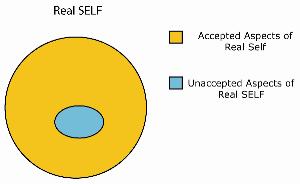
Knowing you
could not survive on your own, you were terrified of being rejected and
abandoned, and so experienced Survival Fear. In order to escape this unbearable fear, you constrained the Unaccepted Aspects of your Real SELF and created a substitute for them. This substitute is an inauthentic subsidiary Self, which SFT labels the Objectified Self[5]

While initially the Objectified Self was a masking Self meant to hide the Unaccepted Aspects of the Real Self, you continued to experience Survival Fear and so you went further in your efforts to escape it. To
ensure that the Unaccepted Aspects of your Real SELF could not be activated, you empowered your Objectified Self to
suppress, repress, and conceptually confine and encage these aspects.
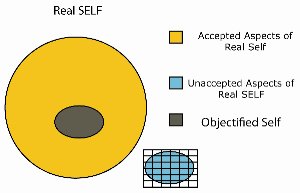
You created and empowered your Objectified Self so that you could survive and escape Survival Fear. To fulfill its purpose, the Objectified Self would like to destroy the Unaccepted Aspects of your Real SELF. Fortunately, this is impossible. But, to emphasize your efforts to abandon those aspects of your SELF, SFT labels them, as a group, the Rejected Real SELF.
Despite the efforts to eject your Rejected Real SELF, it remains a living, growing, sensate part of your SELF. The Objectified Self can contain and confine it only by keeping it disempowered.So, it works to do so, creating more shoulds and more pressure to obey them. And, in its fearfulness, the Objectified Self constricts larger areas of the Real SELF to ensure avoidance of the Survival Fear. So a larger part of your Real SELF is confined. But, it continues to exist, to feel, and, peering out from its entrapment, to learn and grow.
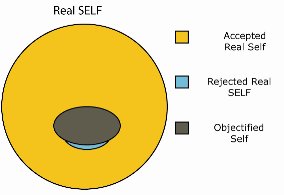
Most
of the psychological barriers and emotional difficulties you experience are
caused by the continued empowerment of your Objectified SELF and suppression of
your Rejected Real SELF.
To Table of Contents To Top of Page
Treatment
Freeing your
Rejected Real SELF and disempowering your Objectified Self puts your entire Real SELF in charge of YOU and
allows you to lead a more healthful, constructive, rewarding life.
With
its help, you learn and become able to nurture, respect, and thereby
empower your entire Real SELF. You make decisions
based on what is the best option for you
in a given situation rather than being controlled by the fears -- the “should”s, “mustn’t”s, and “can’t”s -- of the Objectified SELF.
How is this done?
In SFT, the SELF is viewed as a whole: It is the system upon which therapeutic attention is focused. This mode of conceptualizing psychological problems and the means of helping to resolve them is in contradistinction to reductionist psychotherapies that concentrate on particular subsidiaries of the SELF.
What is meant by subsidiaries of the SELF?
Using Systems "lingo," subsidiaries of the SELF are subsystems of the whole system, which is the SELF. Another way to think of the subsidiaries is as components of the SELF.
Perhaps an illustration will help. [Please note that the sizes of the pie pieces are not meant to signify or imply anything.]
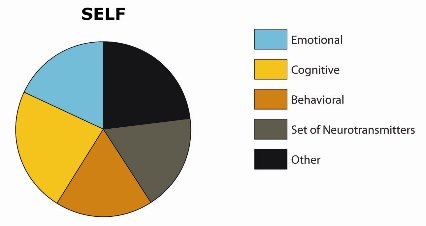
In the illustration above, the four primary components of SELF that are the targets of psychotherapeutic action are depicted and the remainder is denoted as "Other."
The Emotional component is the focus of treatments such as psychodynamic therapy and EFT. Cognitions (e.g., thoughts, attitudes, perceptions) are the therapeutic target of CBT and other cognitive therapies while behavioral therapies work with behaviors. Adherents of a medical model, focus on a goup of neurotransmitters and use medication to redress hypothesized imbalances in these substances.
Rather than reducing its focus to subsystems of the SELF, SFT focuses on the whole SELF. This more expansive focus means that SFT doesn't reduce it's therapeutic target to one slice of the pie, but rather can aim at whatever segment of the pie seems most amenable to creating the desired change.
Guided by its theoretical frame and focusing on the SELF rather than a piece of it, SFT uses any and all of the the techniques developed in other therapies, choosing the interventions that seem most likely to be useful for an individual patient at a particular time in a particular context.
What interventions are utilized in SFT?
As indicated the choice of intervention depends on what you need. However, there are some common features for all patients.
If you start SFT treatment, in the first session you will be advised to get a notebook of a size that you can carry with you on a daily basis. You will use this notebook to carry out many of your homework assignments such as journaling and keeping logs. (Logs are specific types of records; while psychotherapy is more of an art than a science, we still need data to assess the areas and activities that are problematic for you).
SFT is an active therapy. It is a "talk therapy," but to change you must work -- in sessions and between them.
Because of the use of homework, you might get the impression that SFT belongs to the category of Brief Psychotherapy. It doesn't.
SFT is neither a long-term nor a brief psychotherapy. Rather it is an integrated therapy that, while using methods and concepts from each, differs from both.
Unlike lengthy psychotherapies, insight is not the goal of treatment. Unlike many brief psychotherapies, learning to "deal with" your depression and anxiety is not the goal. The aim of SFT is change,
Of course, change is the ultimate aim of all therapies. But, in SFT, the goal is change that enables you to free yourself from the depression and anxiety, the loneliness and confusion caused by the fearfulness of your Objectified Self. This change empowers you to be your Real SELF.
To Table of Contents To Top of Page
SFT Advantages
The
power of SFT derives from its premises, which form a
frame upon which the SFT treatment is built.
Guided by this frame, the entire universe of interventions developed in
all forms of treatment is available for use in a cohesive, coherent, integrated
fashion. The interventions that will be
most effective for you -- in your specific circumstances -- can and will be
implemented.
As with most modern treatments, SFT provides substantial skills training and cognitive remediation.
But, SFT gives you more.
It gives you a way of understanding the bases of your difficulties that makes sense. And it is this understanding, in combination with the skills and modified ways of thinking and perceiving that enable you to continue to improve your functioning and therefore your life long after treatment is ended.
In SFT, you learn to Nurture, and Respect your SELF. Your top priority becomes taking care of your SELF. You learn to love and accept your SELF as s/he is, to use your strengths, free of debilitating internal impediments and self-criticism, to progress toward achieving your goals.
In
brief, you learn a new way of being and doing, and in the process empower YOU.
Using SFT, Dr. Haley has helped many individuals, younger women in particular, to lead happier and more fulfilling lives, to feel and do better by empowering their SELVES. (Read what some of them have attested here.)
